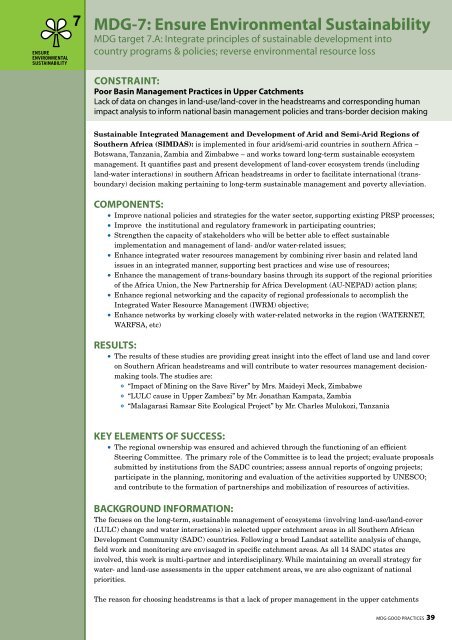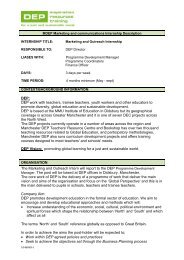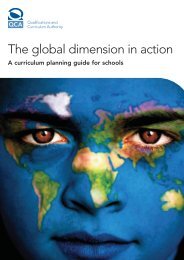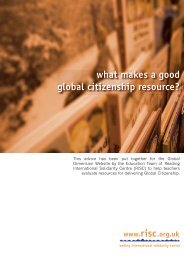Download - United Nations in Cambodia
Download - United Nations in Cambodia
Download - United Nations in Cambodia
- No tags were found...
Create successful ePaper yourself
Turn your PDF publications into a flip-book with our unique Google optimized e-Paper software.
MDG-7: Ensure Environmental Susta<strong>in</strong>abilityMDG target 7.A: Integrate pr<strong>in</strong>ciples of susta<strong>in</strong>able development <strong>in</strong>tocountry programs & policies; reverse environmental resource lossConstra<strong>in</strong>t:Poor Bas<strong>in</strong> Management Practices <strong>in</strong> Upper CatchmentsLack of data on changes <strong>in</strong> land-use/land-cover <strong>in</strong> the headstreams and correspond<strong>in</strong>g humanimpact analysis to <strong>in</strong>form national bas<strong>in</strong> management policies and trans-border decision mak<strong>in</strong>gSusta<strong>in</strong>able Integrated Management and Development of Arid and Semi-Arid Regions ofSouthern Africa (SIMDAS): is implemented <strong>in</strong> four arid/semi-arid countries <strong>in</strong> southern Africa −Botswana, Tanzania, Zambia and Zimbabwe – and works toward long-term susta<strong>in</strong>able ecosystemmanagement. It quantifies past and present development of land-cover ecosystem trends (<strong>in</strong>clud<strong>in</strong>gland-water <strong>in</strong>teractions) <strong>in</strong> southern African headstreams <strong>in</strong> order to facilitate <strong>in</strong>ternational (transboundary)decision mak<strong>in</strong>g perta<strong>in</strong><strong>in</strong>g to long-term susta<strong>in</strong>able management and poverty alleviation.Components:• Improve national policies and strategies for the water sector, support<strong>in</strong>g exist<strong>in</strong>g PRSP processes;• Improve the <strong>in</strong>stitutional and regulatory framework <strong>in</strong> participat<strong>in</strong>g countries;• Strengthen the capacity of stakeholders who will be better able to effect susta<strong>in</strong>ableimplementation and management of land- and/or water-related issues;• Enhance <strong>in</strong>tegrated water resources management by comb<strong>in</strong><strong>in</strong>g river bas<strong>in</strong> and related landissues <strong>in</strong> an <strong>in</strong>tegrated manner, support<strong>in</strong>g best practices and wise use of resources;• Enhance the management of trans-boundary bas<strong>in</strong>s through its support of the regional prioritiesof the Africa Union, the New Partnership for Africa Development (AU-NEPAD) action plans;• Enhance regional network<strong>in</strong>g and the capacity of regional professionals to accomplish theIntegrated Water Resource Management (IWRM) objective;• Enhance networks by work<strong>in</strong>g closely with water-related networks <strong>in</strong> the region (WATERNET,WARFSA, etc)Results:• The results of these studies are provid<strong>in</strong>g great <strong>in</strong>sight <strong>in</strong>to the effect of land use and land coveron Southern African headstreams and will contribute to water resources management decisionmak<strong>in</strong>gtools. The studies are:• “Impact of M<strong>in</strong><strong>in</strong>g on the Save River” by Mrs. Maideyi Meck, Zimbabwe• “LULC cause <strong>in</strong> Upper Zambezi” by Mr. Jonathan Kampata, Zambia• “Malagarasi Ramsar Site Ecological Project” by Mr. Charles Mulokozi, TanzaniaKey Elements of Success:• The regional ownership was ensured and achieved through the function<strong>in</strong>g of an efficientSteer<strong>in</strong>g Committee. The primary role of the Committee is to lead the project; evaluate proposalssubmitted by <strong>in</strong>stitutions from the SADC countries; assess annual reports of ongo<strong>in</strong>g projects;participate <strong>in</strong> the plann<strong>in</strong>g, monitor<strong>in</strong>g and evaluation of the activities supported by UNESCO;and contribute to the formation of partnerships and mobilization of resources of activities.Background Information:The focuses on the long-term, susta<strong>in</strong>able management of ecosystems (<strong>in</strong>volv<strong>in</strong>g land-use/land-cover(LULC) change and water <strong>in</strong>teractions) <strong>in</strong> selected upper catchment areas <strong>in</strong> all Southern AfricanDevelopment Community (SADC) countries. Follow<strong>in</strong>g a broad Landsat satellite analysis of change,field work and monitor<strong>in</strong>g are envisaged <strong>in</strong> specific catchment areas. As all 14 SADC states are<strong>in</strong>volved, this work is multi-partner and <strong>in</strong>terdiscipl<strong>in</strong>ary. While ma<strong>in</strong>ta<strong>in</strong><strong>in</strong>g an overall strategy forwater- and land-use assessments <strong>in</strong> the upper catchment areas, we are also cognizant of nationalpriorities.The reason for choos<strong>in</strong>g headstreams is that a lack of proper management <strong>in</strong> the upper catchmentsMDG Good Practices 39








